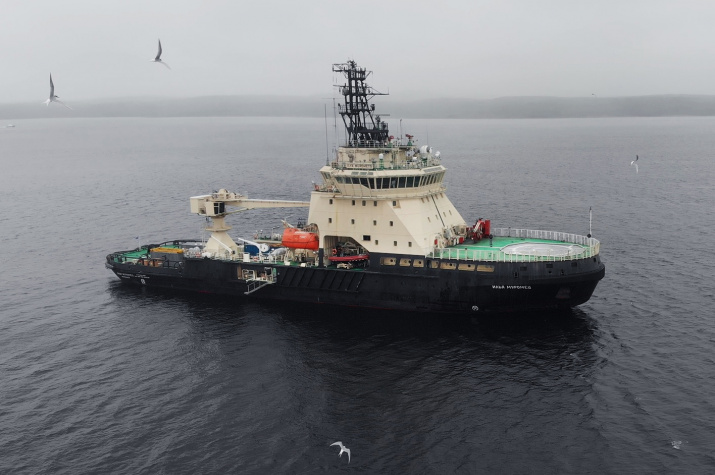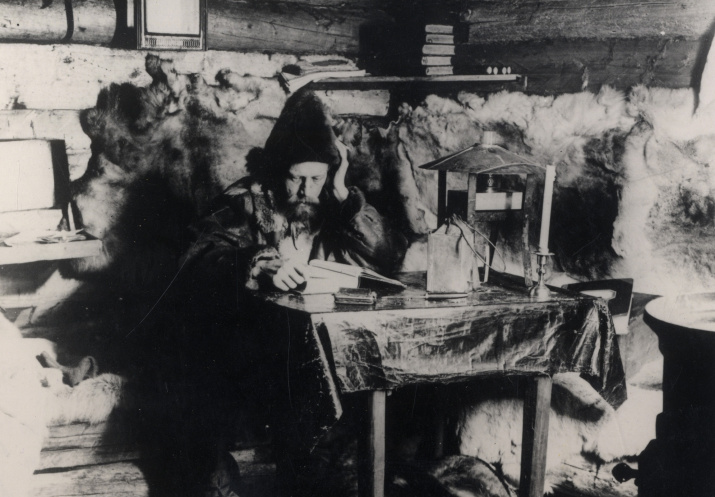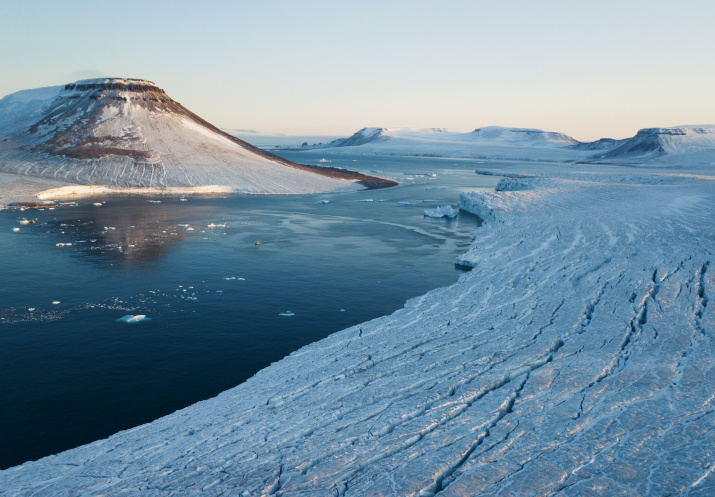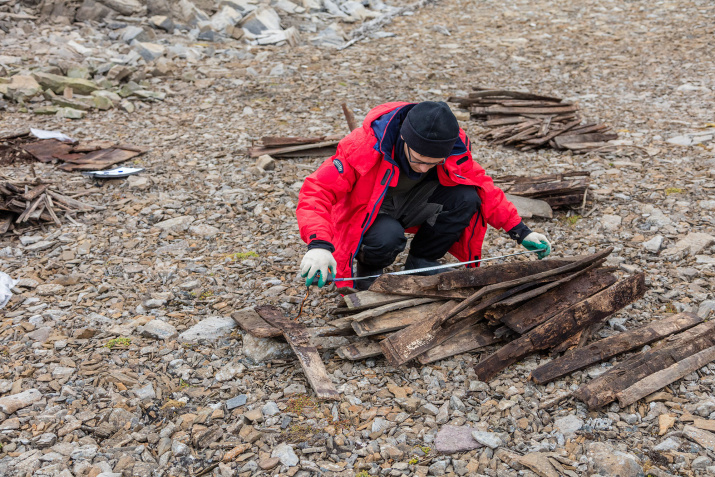The expedition of the Russian Geographical Society and the Northern Fleet to explore the Arctic archipelagos has ended. The members of the expedition covered 11,528 miles, visited eight seas, made 33 landings, and discovered 125 artifacts. Travelers say all this would be impossible without the support of many caring people, relatives and friends. Who and how helped prepare the expedition and ensured its work from the mainland? How were the members of the expedition supported by their relatives? Read about this in our article.
A good expedition is impossible without thorough preparation, including without studying archival materials. The head of the Scientific Archive of the Russian Geographical Society, Maria Matveyeva, helped the travelers. She provided the expedition members with works related to the voyages of Eduard von Toll and Vladimir Rusanov, provided a report by Pyotr Kropotkin on the development of the Arctic, as well as maps necessary to study the route.
"Maria Matveyeva helped with the preparation of reference materials. She gave us a whole bunch of documents, as well as maps from the Cartographic Fund of the Russian Geographical Society. Perhaps in the future some of these historical materials will be published," notes the chief scientist of the expedition, Sergei Churkin.
Arctic explorers Pyotr Boyarsky, Vladislav Koryakin, Nikolai Vekhov and Nikita Kuznetsov made their intellectual contribution to the preparation of the expedition.
"Pyotr Boyarsky, the author of many monographs on the Novaya Zemlya and Franz Josef Land archipelagos, provided information on the Complex Marine Arctic Expedition (CMAE). We used it to monitor cultural and natural heritage sites. Vladislav Koryakin helped us chart a route around Severny Island of the Novaya Zemlya; we actively used his monographs. We were consulted by biologist, publicist on Arctic topics, Nikolai Vekhv; and historian with experience in the Arctic, Nikita Kuznetsov," notes Sergei Churkin.
Although the Arctic is already well studied, it is still full of surprises. In particular, the weather can bring unpleasant surprises. The expeditionary teams corrected their routes based on the current ice conditions. Elena Skripnik, a veteran of the hydrometeorological service of the Northern Department for Hydrometeorology and Environmental Monitoring, helped them in this. An experienced ice forecaster, already retired, she compiled weather reports for the travelers.
“It was a friendly contribution. I worked from home: I took a satellite image, described and gave my forecast. This year the team was very lucky: there was little ice. But still there were storms and many icebergs on the way,” says Elena Skripnik. "I grew up with a dream about the Arctic. Everything connected with these places is very exciting for me. The Arctic is indescribable. The sensations that you experience there cannot be experienced anywhere else. It's good that now there are people like specialists from the Russian Geographical Society who carry the idea of morality, the idea of historical memory. I am glad that I was able to contribute to this large-scale expedition. "
Relatives and friends of the expedition members learned about where exactly the ships were, thanks to the information provided by the director of the research company "RISKSAT", Alexei Kucheiko. The company is engaged in monitoring the Earth from space. It is the same company that supervised a group of schoolchildren who discovered an island off the western coast of Severny Island of the Novaya Zemlya archipelago. The existence of the island was confirmed by the expedition of the Russian Geographical Society and the Northern Fleet.
“We met Alexei Kucheiko because of the discovery of the island by the schoolchildren,” says Sergei Churkin. “During the expedition, using satellite data, he helped track where the expeditionary teams were. And we notified relatives who were away from their loved ones. "
The families of the travelers are looking forward to the return of their heroes. Quite recently, a son was born to one of the expedition members, an employee of A.N. Severtsov Institute of Ecology and Evolution RAS, Alexander Chesnokov. The members of the expedition celebrated this touching event with tea and pastries on board the “Ilya Muromets” icebreaker. To the baby, they wished to become an admiral or a naval specialist.
“We do not know exactly when my husband will be able to return home, but, of course, we are very much looking forward to seeing him. And he himself really wants to see his son,” says Aleksandr Chesnokov’s wife, Elena. “During the expedition, we communicated by satellite phone, mainly when the ship was in the port. On average, we called once a week. The husband is delighted with the expedition. He is very glad that he managed to meet interesting people, learn something new. I, in turn, support his aspirations and undertakings. "
In solidarity with Elena Chesnokova is Miroslava Edemskaya, the wife of another member of the expedition, Dmitry Edemsky, an employee of the Institute of Terrestrial Magnetism, Ionosphere and Radio Wave Propagation of the Russian Academy of Sciences.
"Of course, it is not easy for loved ones to endure such long expeditions, but we treat them with understanding. My husband was impressed by the ship, conditions, colleagues, and the opportunity to work. We support him, we miss him. Colleagues from IZMIRAN call, envy in a good way, friends call as well. At home, our cat, his main adorer, is missing him the most," says Miroslava Edemskaya. "Such projects are a huge gift for scientists. This is an opportunity to collect unique material necessary for further work, exchange experiences with people from various fields of science, find points of contact between their research, generate ideas at the intersection of different sciences. To be in such an environment is a great joy, it inspires, gives energy. Today's project is simply unique. "
“In the age of the Internet and unimpeded communication, it was very difficult for me to suddenly find myself without contact with the closest person,” says Maria, the wife of an expedition member, employee of the Institute of Earth Physics of the Russian Academy of Sciences, Ruslan Zhostkov. “But I felt that this was a chance for me to develop qualities and skills that were not previously in demand. I became a plenipotentiary acting head of the family, without the opportunity to consult in making important decisions. I did it, and now I feel more confident! In addition, I am very glad that my husband has a job that he loves, where he is constantly improving and achieving new successes. It is a great luck that he became a part of such a large-scale and important project, to obtain unique data for his scientific work. My children and I are very proud of him. "
We would like to remind you, that the complex expedition of the Russian Geographical Society and the Northern Fleet to the Arctic archipelagos started on August 5 in Severomorsk. The expedition followed the route of the great polar explorers Vladimir Rusanov and Eduard Toll. The scientists of the Russian Geographical Society and the military men were looking for unique artifacts reflecting the history of the exploration of the Arctic in order to supplement the knowledge about its pioneers.
The expedition consists of two teams. The first one sailed on August 5 from Severomorsk on the “Ilya Muromets” icebreaker. It repeated the route of the first Russian polar expedition of 1900-1902 led by Baron von Toll - along the northern shores of Taimyr to Bennett Island. It includes scientists, search specialists, historians and the RGS media group. The team is expected to complete its work on 23 October in Murmansk.
The second team of the expedition set off on August 10 on the sea tug MB-12 and had completed the research by the beginning of September. It surveyed the coastal area of the Novaya Zemlya. The members of the expedition passed by Severny Island along the route of Rusanov, which, in 1910, was the first Russian scientist to sail there on the yacht "Demetrius of Thessaloniki". The travelers discovered unique historical artifacts, and a new island and a strait.







